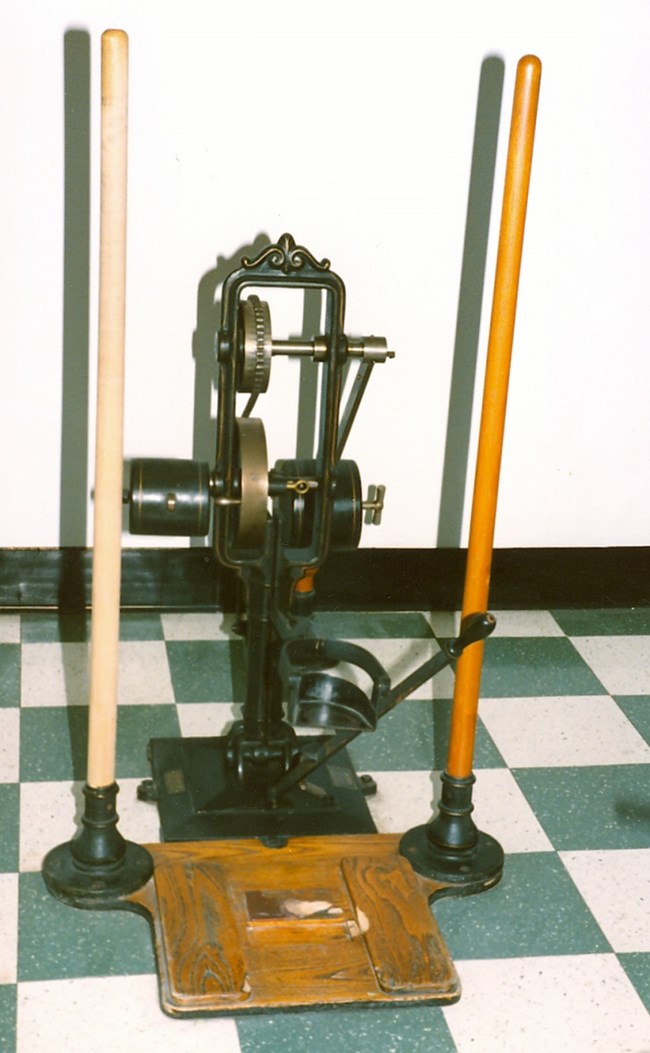
NPS Photo Zander: A Man Ahead of His Time Dr. Gustav Zander was born in Stockholm, Sweden on March 29, 1835. In his youth, medical gymnastics (introduced by Per Henrik Ling) were in vogue. Although Zander became expert at this exercise, he recognized that its value was limited by its use of assistants to apply the resistance necessary for improved muscle tone. Manual resistance was affected by the strength, physical state, and mental attitude of the assistant. Zander realized that therapeutic machines could supply steady resistance indefinitely. Their potential for providing a standardized workout for all users meshed well with the graduated goals of physical therapy. Zander experimented with mechanical therapy systems throughout the 1850s. He devised a novel approach to physical therapy based on machines that used weights and levers to vary resistance. The lever worked as an extension of the muscle group being exercised. Sliding the weight towards the end of the lever increased resistance, thus increasing muscle workload. Moving it closer to the user lessened resistance. This feature allowed each machine to be adjusted to suit each individual's strength. Adjusting another set of weights and levers compensated for the body or limb weight of the user. This precise calibration created a level playing field for each new user. Resistance could also be increased over time for an individual seeking to increase strength. For those with paralyses or extreme weakness, motorized machines kept the affected muscles from atrophying. After becoming a licensed physician in 1864, Zander put his ideas into practice at a local Stockholm school by setting up prototype therapy machines for the students. Their strength and health improved markedly, prompting Zander to open the Medico- Mechanical Institute in Stockholm to promote his machines. At first medical practitioners viewed the enthusiastic claims for the new therapy with skepticism bordering on hostility. As solid evidence of patient improvement mounted, though, an increasing number of practitioners worldwide endorsed Zander’s therapy, enabling him to open a second Zander Institute in London. In the 1880s Dr. Zander came to New York to establish an institute near Central Park. When Dr. Zander died in Stockholm on June 17, 1920, he was world- renowned for his innovative approach to physical therapy. Unfortunately his death, coinciding with the after- effects of World War I and the world- wide depression of the 1930s, swept his machines into the backwash of history. But in the last decades of the twentieth century, his revolutionary ideas were once again receiving the attention and respect they merited. The Thoroughly Modern 1915 Bathhouse Samuel W. Fordyce, owner of the Fordyce Bathhouse, planned every detail of its construction with the goal of creating a state- of- the- art operation. Accordingly he fitted the bathhouse with the most innovative hydrotherapy and mechanotherapy equipment available. In December 1914 he ordered several exercise machines from the Kny- Scheerer Company of New York, manufacturers of surgical instruments. Three were Zander machines: the F-1 universal vibratory (seen in the center of the exhibit), the F-2 mechanical horse, and the A-1 combination apparatus for upper extremities. In January 1915 he added a fourth, the B-1 medico- mechanical combination. All four were removed from the bathhouse long ago, perhaps in 1944 when electrical and mechanical equipment was eliminated from bathhouse massage departments. But during the Golden Age of Bathing, when the Fordyce was in its heyday, this specialized equipment offered therapeutic exercise of a quality that would not be available again for nearly fifty years. Many people came to the bathhouse with conditions that kept them from exercising vigorously. Zander’s machines were variable weight resistance systems ideal in this setting. They allowed people with weakness or mobility problems to start out with gentle resistance and gradually work their way up to more strenuous exercise. Zander machines could also help patrons make a smooth transition from infirmity to active outdoor exercise, an essential part of the spa cure. Zander Machines and The Homestead The Zander machines formerly used in the Fordyce Bathhouse and those exhibited were sold by KnyScheerer in the early twentieth century. The exhibited machines were originally purchased by and used at “The Homestead,” the famous spa in Hot Springs, Virginia. In 1911 Dr. Kurt Linert of Vienna installed a total of thirty- six Zander machines at the Homestead and trained attendants in their proper use. After years of use the remaining machines were removed and placed in storage. In December 2000 Virginia Hot Springs, Inc. (the current owners of The Homestead) generously donated the devices seen here to Hot Springs National Park so that the public could view these remarkable machines and learn something of their history. The collection in Fordyce Bathhouse is the largest known to exist in the U. S. today. |
Last updated: December 22, 2020
